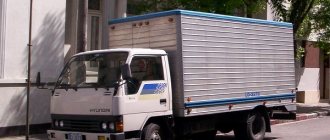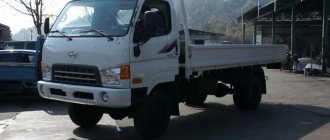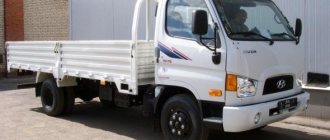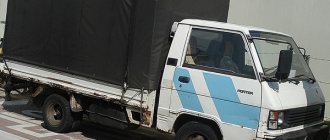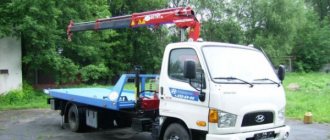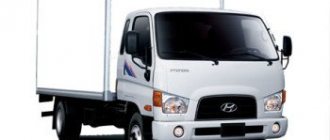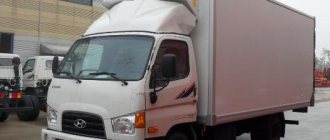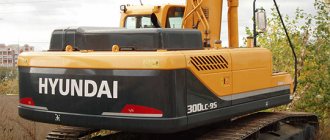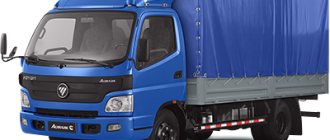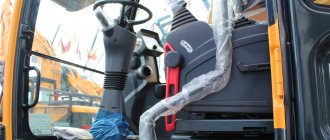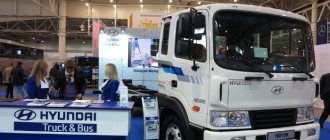Hyundai HD72 is a light duty truck designed and manufactured by the Korean manufacturer Hyundai.
The Hyundai HD78 model was taken as the basis for this truck. As a result, the new car received many technical solutions borrowed from the HD78. But its distinguishing feature is its slightly reduced carrying capacity, amounting to 7200 kilograms. It is worth noting that the numbers in the index indicate the maximum load capacity of the model.
Story
The first display of this truck took place in 1986. Then the car was presented under a different name. Over the entire period of mass production, the manufacturer has repeatedly updated the model, which has now allowed it to take a leading position in the Russian market among other small-tonnage vehicles.
The most serious improvements were carried out twice, in 1998 and 2004. But restyled versions are now not available to Russian consumers, at least in new technical condition. The official Hyundai dealer instead offers a more load-bearing model, produced under the name Hyundai HD78.
About the history of the model and its place in the Hyundai truck line
Compact Korean Hyundai trucks have been well known in the domestic market since the second half of the 90s. The most common model, according to Rosavtostat, has been the Hyundai HD78 for many years with a payload capacity of 4.6 tons. Another bestseller is the nimble “baby” Hyundai Porter and Hyundai Porter II, which takes a ton of cargo “on board”.
Hyundai HD65 is in the “cargo line” between them. or rather, between the Hyundai HD78 and the Hyundai HD35 semi-truck.
The first medium-duty Hyundai trucks were produced in 1987. They were not homegrown cars. Their launch into mass production was the fruit of cooperation between Hyundai and the Japanese concern Mitsubishi. The first generations of Hyundai medium-duty trucks, called “Hyundai Mighty,” were close to the original copies of the Japanese Mitsubishi Fuso Canter trucks.
Hyundai Мighty HD65, also known as Mitsubishi Fuso Сanter, at the turn of the 80s/90s.
But since 1998, Hyundai has already been producing trucks, each of which can rightfully be called the Korean company’s own development. The Hyundai Mighty trademark, which formally includes both the HD65 and HD78, has experienced a revival today. In 2015, a grand presentation of the modern Hyundai Mighty truck was held in Korea, and in 2017, assembly of two modifications of the Mighty began in Russia.
The Hyundai HD65, which was also assembled here at the Kaliningrad company Avtotor, on the contrary, left the Russian market, and from now on it can be purchased in the Russian Federation only in a used version. Production of the Hyundai HD65 continues only for third world countries - such as Indonesia, Cambodia, Malaysia, etc.
Purpose
The Hyundai HD72 truck is most often used for intracity transportation. On the Russian market, this model is quite a strong competitor to domestically produced light-duty vehicles, such as the GAZelle. And if some parameters are similar, then in terms of qualities such as maneuverability and comfort, the Korean truck has a significant advantage.
Thanks to its advantages, of which there are many, the Hyundai HD72 is quite popular in small and medium-sized businesses, where in addition to intracity routes, the car often operates intercity and even interregional flights.
The scope of application is significantly expanded by various add-ons and equipment. Thus, this model is often found in public utilities and special city services, where it is often equipped with a crane, tow truck or other similar equipment.
Modifications
Hyundai HD72 is not a single model, but a whole family that includes unified trucks. They are presented in five main options, having different wheelbases, different all-metal cargo platforms (the shortest is 3400, the longest is 4300 millimeters), loading height (the smallest is 900, the largest is 1115 millimeters), as well as several options for installed cabins.
Speaking of cabins. In addition to different designs, the cabins also have different widths, being either 1760 or 2000 millimeters. As for the length, they are manufactured in three versions, namely:
- Short, with three seats, of which one is for the driver and the other two are for passengers;
- Extended, in which the total length of the cabin is increased by 300 millimeters;
- Double, already having six seats.
The chassis of this truck turned out to be quite versatile, which allows you to convert the vehicle for a wide variety of tasks. So, Hyundai HD72 can be equipped with:
- Crane-manipulator installations;
- Tipper loading platform;
- Onboard cargo platform;
- Isothermal vans;
- Bread vans;
- Industrial goods vans;
- Refrigerated vans;
- Evacuation equipment;
- Tent cargo platforms;
- Automobile tanks;
- Communal equipment.
Appearance
The main focus of the Korean brand Hyundai is still passenger cars. But despite this, the trucks produced are completely different from them, even in small details. The entire cargo line has a rather simple and modest appearance. It is worth noting that the manufacturer himself notes that during the development process there was no goal to create an incredibly beautiful car. But the appearance turned out to be quite pleasant and at the same time quite practical.
Due to the fact that the cabin is installed separately from the body and does not have any connections with it, it was possible to achieve an increased level of comfort for both the driver and passengers. In addition, such a solution made it possible to improve management.
Each of the produced modifications, in addition to its technical characteristics, also differs in small design details. All models have a trapezoidal false radiator grille with rounded corners. Depending on the version of the car, the grille may have either only horizontal partitions, or also horizontal ones, but supplemented by a pair of vertical ones.
The manufacturer placed a large brand emblem in the central part of the grille. Another one is located on a solid metal sheet. Along the perimeter, the grille has a wide rounded stamping, which immediately catches the eye.
An equally noticeable element is the windshield, which is quite large in size. The upper part of the glass stretches all the way to the roof, its sides are almost invisible. Below the glass, the cabin is equipped with several brand nameplates and, of course, windshield wipers.
Front lighting equipment deserves special attention. The headlights have a square shape and a sloping top base, which is found in many Korean-made trucks. Direction indicators are installed next to the headlights. They are still a separate element, although they look integral with the headlights.
The front bumper, which has a rectangular shape, complements the appearance and provides passive safety. In many versions of the truck, this element is painted gray, but there are often versions with a bumper painted in the color of the cab. The bumper has a wide slot that acts as an air intake, as well as a pair of round fog lights occupying the corners of the bumper.
On the side, the cabin has a wide stamping that occupies the entire middle part. Below it, the cabin is equipped with another turn signal. The wheel arch is actually quite difficult to notice at first glance. Here, thick plastic was used as fender liners.
Access to the cabin is simplified by a miniature step mounted below the door. On the doors themselves in the front part there are rectangular mirrors with very wide brackets.
The rear of the car has been further simplified. By the way, it is in the rear that all modifications differ noticeably from each other. The lower part of the frame can be equipped with a bumper having a pair of lights.
Refrigerator Hyundai HD78
Reinforced chassis for the unit come from Korea, after which isothermal vans are installed on them. This is done by a plant from Nizhny Novgorod “NizhSpetsAvto”, as well as an enterprise from Vladivostok called “AK MOTOR SERVICE”. Both manufacturers are distributors of Hyundai.
Note that the seventy-eighth model began production in 2008, becoming a more advanced replacement for the Hyundai HD72. The car became more comfortable and acquired a more powerful diesel engine with 140 horsepower, and its load capacity increased to 4.9 tons. The main ones have increased and fog lights have appeared.
The large windshield, which provides excellent visibility, as well as the robust chassis design, adapted to unimportant domestic roads with their bumps and potholes, remained unchanged.
The chassis is quite powerful and the ABS system is used. The engine does not require a lot of fuel. It has a simple electronic control circuit that does not create problems during repair.
The van can use one of the types of thermal insulation: from budget polystyrene foam to sandwich panels. The latter allow you to transport even deep-frozen goods over long distances.
Purpose
Using the Hyundai HD 78 refrigerator, you can transport all kinds of products that require low storage temperatures. These are, for example, fresh or frozen vegetables, fruits, meat and fish, cakes and pastries, and semi-finished products. In addition, the machine is used for drug delivery.
Depending on the application, manufacturers can offer different van designs. Thus, it is convenient to transport ice cream in a car with eight doors, and confectionery in a refrigerator with doors located on the side. A carcass truck has a special design inside for transporting animal carcasses.
Photo of the Hyundai HD 78 refrigerator
Advantages and disadvantages
Positive traits:
- The engine does not consume much fuel and pulls well at low speeds. Access to the diesel engine is very convenient.
- The cabin can be easily tilted to 55 degrees alone. It is spacious, with seating for three, with good visibility and high-quality air conditioning.
- A useful option is heated mirrors.
- The low base allows you to unload and load goods as quickly as possible.
- Soft suspension, comfortable brakes, reliable grip, durable frame.
- No problems with service and spare parts.
Negative qualities:
- The driver's seat is harsh and not very comfortable. The passenger seat cannot be adjusted.
- The tight gearbox with a cable is not very convenient. In the first gears, it does not always work clearly, and when switching sharply, the cable can break.
- On an undulating road, high softness of the suspension can lead to longitudinal vibrations.
- Due to a design flaw, water may enter the rear axle gearbox through the breather.
- On uneven roads, the mechanism for tilting the cab rattles. This can be “treated” by inserting an additional gasket.
Cabin
The interior of the Hyundai HD72 truck came out very pleasant and comfortable. The cabin has an all-metal structure made by stamping.
Like most similar trucks, there is no hood, and half of the entire cabin area is occupied by large windows.
But it is worth noting that the cabin is quite large. Thanks to this, it was possible to increase the free space inside it, and this already has a positive effect on comfort for both drivers and passengers. Rubber cushions are used as suspension for this design. As practice has shown, they significantly smooth out road irregularities.
As described earlier, the interior of the model turned out to be very pleasant in appearance. The driver's seat is equipped with a two-spoke steering wheel with a large central part. The steering column itself is equipped with a tilt adjustment. Behind the wheel, the manufacturer placed an archaic dashboard made of plastic. However, this is only in the standard version, while more advanced ones can have a panel with a wood finish.
The center panel is equipped with all the main controls, audio system, ventilation system and air conditioning controls, which are installed on the truck as an additional option. There are also air ducts here. On the side of the driver's seat there is a gear shift lever and a handbrake, which is basically the same as on other similar cars.
The standard cabin is equipped with a driver's seat and one passenger sofa, the width of which is sufficient to comfortably accommodate two passengers. Seat belts are available not only on the driver's side, but also on the passenger side. Moreover, they have a tensioner. The driver's seat is very comfortable. It has several adjustment parameters, good support, and a spring suspension, which makes work even more comfortable.
Steering wheel and instrument panel
The diameter of the steering wheel and the thickness of the rim ensure ease of control and are fully consistent in quality with a passenger car. Steering column switches are a standard development of the Korean automobile industry.
The one-piece design of the hydraulic booster and steering wheel of the Hyundai ND 72 ensures reliability, wear resistance and long service life.
Return to content
Additional options
In addition to the basic equipment offered, the truck can be additionally equipped with other options, including front wheel disc brakes, an ABS system, a power take-off, air conditioning, as well as very effective climate control.
Engine access
To provide access to the engine, the manufacturer did not come up with anything new, but used a classic solution for cabover trucks, represented by a special mechanism that tilts the cab forward.
This mechanism reclines quite widely, which allows you to get to the main components and assemblies without any difficulty. This greatly simplifies the process of maintenance and repair.
Wheels and tires Hyndai HD 65, 72, 78
kgf / cm ? ( PSI *)
| Characteristic | |||||
| Standard size | Air pressure kgf / cm ? ( PSI *) | Dimensions | Air pressure | ||
| HD65 | Narrow | 7.00R16-10PR | 5,0(71) | 205/75R 17.5-10PR | 7,0(100) |
| Narrow low profile | 195R15-12PR | 5,9(84) | — | — | |
| Wide | 7.00R16-12PR | 6,0(85) | 205/75R 17.5-10PR | 7,0(100) | |
| Wide low profile | 195R15-12PR | 5,9(84) | 195/75R 16-10PR | 5,9(84) | |
| HD72 | Wide | 7.50R16-12PR | 6,5(93) | 7.50R16-14PR 8.50R17.5-12PR | 7,4(105)6,3(90) |
| HD78 | Wide | 7.50R16-12PR | 6,5(93) | 7.50R16-14PR 8.50R17.5-12PR | 7(100)6,3(90) |
| Wide short axle | 7.50R16-14PR | 7,0(100) | — | — | |
Specifications
Engine
The range of installed power units was partially borrowed from older models. All engines run on diesel fuel and have four cylinders arranged in a row. Several options are equipped with a turbocharging system and intermediate cooling of charge air (intercooler). Depending on the modification, the maximum output power can be 130 or 150 horsepower. The displacement also varies between 3.3 and 3.9 liters. It is worth noting that for the standard configuration of the truck, an atmospheric unit was often used, producing an output power of 120 horsepower. But in addition to it, a 115-horsepower variation, equipped with turbocharging, was also installed.
Engine service life
Each engine is assigned the same service life of two hundred thousand kilometers. However, with timely maintenance and gentle operation, engines often overcame this milestone without serious breakdowns.
As for maintenance, this process is carried out every 15 thousand kilometers. Consumables such as filters and oil are replaced every 10 thousand kilometers, regardless of what kind of oil is used (mineral or synthetic).
Fuel consumption
The average fuel consumption for all engines is about 17-20 liters, depending on the load level. The fuel tank has a volume of 100 liters, which is quite enough for long-term operation.
checkpoint
The engine is paired with a non-alternative five-speed manual transmission equipped with a single-plate, dry clutch with a damper and a hydraulic release drive.
Gear changes are carried out using a cable drive. Thanks to this solution, it was possible to reduce the travel of the gearshift lever, as well as increase the accuracy and speed of gear shifting.
Engine
The Hyundai HD 72 model is equipped with four-stroke water-cooled diesel units with a capacity of 130 and 150 hp. with a working volume of 3.9 liters. In addition, modifications with a 3.3-liter engine equipped with a turbocharging system with an intercooler with a power of 115 hp are supplied to the Russian market. All power units are four-cylinder, in-line. The power plants differ from each other in minor design features and installed service systems. The D4DD engine series is distinguished by the presence of an electronic fuel injection control system. Almost all car modifications supplied to the Russian market are equipped with systems that ensure reliable engine starting at low temperatures. Most cars found on Russian roads are equipped with engines that meet Euro-3 environmental requirements.
Brake system
The truck has a hydraulic brake system with two circuits. As for the brakes, they are drum brakes, on each wheel. However, disc brakes for the front axle wheels are also available as an option.
The parking brake is a drum brake mechanism that blocks not the wheels, but the driveshaft. Like other models, it has a cable drive.
To ensure greater safety and braking efficiency, the manufacturer equipped the truck with ABS and ASP systems.
As additional options, an engine brake is offered, which allows you to significantly relieve the load from the main braking system of the car in case of long descents. This increases the durability of brake components, since they wear out more slowly. In addition to descents, this type of brake is often used in urban conditions in winter. The engine brake is activated by a special lever located under the steering wheel on the right side. It should be noted that the brake is applied only when the gas pedal is released.
Equipment Hyundai HD 72
- central locking;
- wiring for installing an audio system;
- heating system;
- tachometer
- mountain brake;
- electric windows;
- heated mirrors;
- fog lights;
- ABS
An option is the installation of an engine brake, which helps reduce the load on the main braking system of the Hyundai ND 72 during long descents. This has a positive effect on durability and reduces wear on units. It can also be used within the city in winter. The system is activated via the control lever located under the steering wheel on the right. It turns on after the driver releases the gas pedal.
Chassis
The truck is built on a durable metal ladder frame.
At the front, a dependent suspension is used, which includes semi-elliptic leaf springs, bidirectional hydraulic telescopic shock absorbers, and an anti-roll bar.
A dependent suspension was also used at the rear, almost identical to the front. But it does not have shock absorbers.
dimensions
- Total length – 5280 mm;
- Total length – 6075 mm;
- Total length – 6515 mm;
- Cabin width – 1760 mm;
- Cabin width -2000 mm;
- Platform width – 2170 mm;
- Total height – 2250 mm;
- Total height – 2360 mm;
- Wheelbase length – 3400 mm;
- Wheelbase length – 3570 mm;
- Wheelbase length – 3735 mm;
- Wheelbase length – 4300 mm;
- Front track width – 1667 mm;
- Rear track width – 1495 mm;
- Ground clearance – 200 mm;
- Ground clearance – 260 mm;
- Loading height – 900 mm;
- Loading height – 1115 mm.
Peculiarities
Hyundai HD72 is quite well known on the Russian market. This model has proven itself to be a reliable, durable, comfortable and unpretentious workhorse that can cope with many tasks.
The cab design uses rubber cushions as its own suspension, due to which road unevenness is significantly smoothed out, thereby making driving a truck similar to driving a car.
Among the main features, good technical adaptation to Russian operating conditions should be highlighted.
Any of the installed power units can operate properly even on domestic brands of diesel fuel, which is often not of very high quality. Maintenance of this truck does not cause any particular difficulties, since all consumables are not only quite widespread, but also have a very affordable price. The same can be said about specialized service centers, of which there are more than two hundred in different regions in Russia.
The presence of a special mechanism that tilts the entire cabin forward 50 degrees greatly simplifies access to the engine and many other components.
As many drivers note, the Hyundai HD72 has very good traction indeed, even from the initial revs. Due to this, the first gear of the transmission is needed here only in order to move away with a fully loaded body, and in an empty state you can quite easily start moving from second gear.
The highest speed a truck can reach is 80 kilometers per hour. The cruising speed remains at 75 kilometers per hour. Of course, this is not particularly enough for modern traffic on highways, but for working in urban conditions such indicators are more than enough.
On engines that use a turbocharging system, turbines from the American manufacturer Garrett and the Japanese Mitsubishi can be installed. It is important to note that, depending on the installed turbine, certain operating rules must be followed. Thus, an American turbine requires careful handling, since under harsh operating conditions this element can quickly fail and, in addition, lead to very expensive repairs. To extend its service life, it is necessary to leave the engine idling for some time after hard work. Thus, the device is cooled. Japanese turbines have higher resistance to harsh operating conditions.
On modern modifications, the standard equipment has a number of useful options, namely electric windows, central locking, electrically heated side mirrors, fog lights, a driver's seat with spring suspension and many other equipment that improve operating comfort.
The two-spoke steering wheel has an optimal diameter and rim thickness, which together makes steering comfortable and very similar to passenger cars.
The salon is equipped with a dashboard made of plastic. As standard, it is plain, while in richer versions, there are plastic inserts that imitate a wood structure.
Passenger seats are represented by a sofa. However, the back on it is divided into two parts. If necessary, the central backrest can be folded forward, thereby turning into a small table with cup holders and a drawer for storing some things and documents. Moreover, this box has a lockable lid.
Malfunctions and repairs
Defects and repair methods for the HD72 truck:
- Difficulty starting the engine after overnight parking with the formation of smoky exhaust. The cause may be a breakdown of the starting relay, which is responsible for supplying power to the glow plugs. Repairing the Hyundai HD 72 in this case consists of checking the electrical circuits and installing a new relay. Instead of the original unit, you can choose an analogue from domestic cars.
- Difficulty turning the steering wheels, accompanied by whistling of the power steering pump drive belt. The cause of the defect is wear of the support bearing units on the steering knuckle or a jammed kingpin, which rotates in the seat in the front axle beam. Repair of Hyundai HD 72 consists of inspecting the steering mechanism, identifying and replacing worn elements. At the same time, it is recommended to check the condition of the drive belts and the cleanliness of the hydraulic fluid in the booster.
- Jumping while driving indicates uneven tire wear or an incorrectly balanced wheel. The appearance of strong noise from the suspension when transporting light loads indicates breakage of the rear spring leaves or wear of the bushings. Increased noise from the rear axle suspension on a loaded vehicle occurs when the spring brackets or ladders are damaged, as well as when the rubber bumper is destroyed. Damaged elements need to be replaced.
Flaws
As the owners note, this truck has only one significant drawback related to the fuel system.
If the fuel tank is completely empty, the fuel system circuits are filled with air. If this happens, then even with a full refueling it will not be possible to bring the truck into working condition. This problem can only be solved at service centers, where the circuits are purged and the power unit is subsequently adjusted. Of course, it is still possible to avoid it, and to do this you just need to monitor the fuel level and prevent it from being completely used up.
Price
Official Hyundai dealers located in Russia are not currently selling new Hyundai HD72 trucks. However, the secondary market has a ton of used car offerings.
The greatest demand has always been for modifications that have an isothermal van on board. The cost of such versions, released between 2005 and 2007, varies from 400 thousand to 600 thousand rubles. For more recent samples, produced in 2011, owners ask for 900 thousand rubles and more, depending on the technical condition and mileage.
Trucks equipped with crane-manipulators remain no less popular. If we consider models produced between 2005 and 2007, the cost of such modifications varies from 900 thousand to 1.1 million rubles.
It should be noted that, to a large extent, the price tag for a truck is assigned primarily depending on the installed superstructure, and only then the technical condition and mileage are taken into account.
